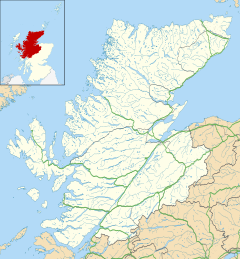Fort William, Scotland
Fort William
|
|
|---|---|
 Fort William High Street |
|
| Fort William shown within the Highland council area | |
| Population | 10,000 |
| OS grid reference | NN 10584 74114 |
| • Edinburgh | 134 mi (216 km) |
| • London | 512 mi (824 km) |
| Council area | |
| Country | Scotland |
| Sovereign state | United Kingdom |
| Post town | FORT WILLIAM |
| Postcode district | PH33 |
| Dialling code | 01397 |
| EU Parliament | Scotland |
| UK Parliament | |
| Scottish Parliament | |
Fort William (Scottish Gaelic: An Gearasdan [ən ˈkʲɛrəs̪t̪ən] "The Garrison") is the second largest settlement in the Highlands of Scotland with around 10,000 inhabitants – and the largest town: only the city of Inverness is larger.
Fort William is a major tourist centre, with Glen Coe just to the south, Aonach Mòr to the east and Glenfinnan to the west, on the Road to the Isles. It is a centre for hillwalking and climbing due to its proximity to Ben Nevis and many other Munro mountains. It is also known for its nearby downhill mountain bike track. It is the start/end of both the West Highland Way (Milngavie-Fort William) and the Great Glen Way (a walk/cycle way Fort William-Inverness).
Around 726 people (7.33% of the population) can speak Gaelic.
Questions over the town's English name are various. The post-Glorious Revolution fort was named Fort William after William of Orange, and the settlement that grew around it was called Maryburgh, after his wife. This settlement was later renamed Gordonsburgh, and then Duncansburgh before being renamed Fort William, this time after Prince William, Duke of Cumberland; known to some Scots as "Butcher Cumberland". Given these origins, there have been various suggestions over the years to rename the town (for example, to Invernevis). These proposals have led to nothing.
...
Wikipedia

